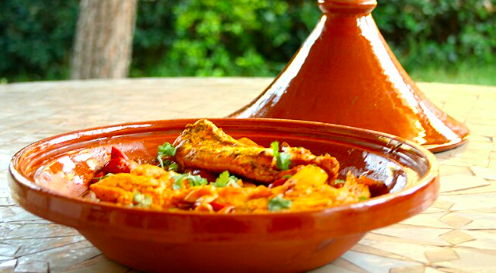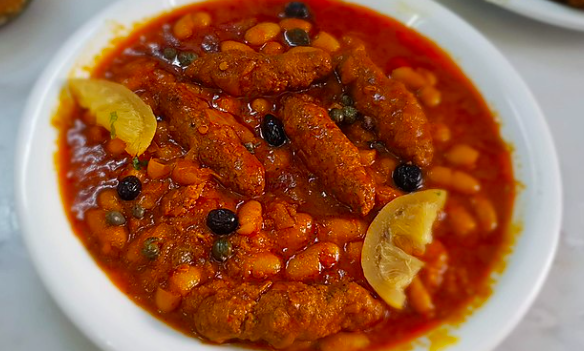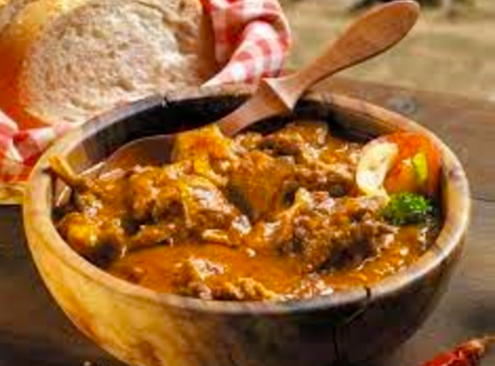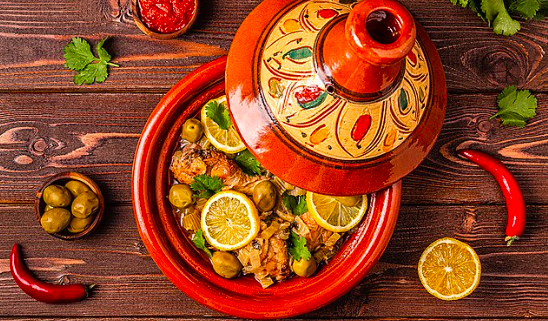Tajine - Morocco’s Tasty Contribution to the Culinary World
By: Habeeb Salloum/Arab America Contributing Writer

My first introduction to tajine, a dish that vies with couscous as Morocco’s national dish, took place in Rabat at the home of my friend Idriss. I had met him during his student days in Toronto after he had finished his studies at Laval University in Quebec City. Before he returned to his country, he, with his wife, Amina, had spent some time as our guests and had invited us many times to visit them in Morocco.
Now, sitting amid the luxurious Moorish architecture of Idriss’s home, I watched a maid place before us a large steaming dish of what appeared to be a colourful stew. Noticing that I was looking at the dish before us, Amina remarked, “It’s called Tajine Fas! I’m from the city Fez and we are renowned for our tajines.” She smiled as she urged us to dip into that well-known Moroccan dish. The taste was heavenly.
Tajine, similar to the French etouffé, is both the name for a vast number of stews found on the menus of every Moroccan eating place and the shallow and handless earthenware utensil with a cone-shaped lid in which they are cooked. It derives its name from the Greek teganon (frying pan) and is believed to have a history to the times that the Greeks were in North Africa.
Prepared from fish, chicken, lamb or other meats and a wide variety of vegetables, tajines are fragrant, tart, spicy and sweet. Stewed with fruits, olives, lemons, herbs, and spices, and simmered to produce tasty sauces, they are a perfect answer to a hungry person’s dreams. When slowly cooked in tajine earthenware, they reach their epitome of flavour. The mouth-watering taste of steaming tajines are as a result of the conical lid capturing the steam and juices from all the ingredients simmering together for long hours over very low heat without the cover being removed.
These few dishes are my own creations of traditional Moroccan tajines – minus the long hours of cooking. They are at their best when eaten by dipping crusty bread into the stew, or with a side dish of mashed potatoes or cooked rice.
Okra and Tomato Stew – Tajine Mlokhia

Serves 4 to 6
5 tablespoons olive oil
1 package frozen okra (10 oz 300 g), thawed
1-pound beef or lamb, cut into 1-inch cubes
2 medium onions, finely chopped
4 cloves garlic, crushed
1/2 small hot pepper, seeded and finely chopped
2 cups stewed tomatoes
1 cup water
1 1/2 teaspoon salt
1 teaspoon black pepper
1 teaspoon cumin
1/2 teaspoon allspice
1/2 teaspoon turmeric
In a saucepan, heat the oil, then sauté okra over medium for 8 minutes or until pods begin to brown, turning them over frequently. Carefully remove with a slotted spoon and set aside.
In same oil, add more, if necessary, sauté meat over medium heat for 10 minutes, then add onions, garlic and hot pepper and sauté for another 10 minutes or until onions begin to brown. Stir in remaining ingredients, including okra, then cover and simmer over low heat for 40 minutes, adding more water if necessary. Serve immediately.
Lamb Stew with Prunes and Honey – Tajine Fas

Serves about 6
4 tablespoons olive oil
2-pounds lamb cut into 1-inch cubes
1 medium onion, finely chopped
1/2 cup finely chopped coriander (cilantro)
2 cloves garlic, crushed
2 teaspoons salt
1/2 teaspoon ginger
1/2 teaspoon black pepper
1/2 teaspoon dried tarragon
1/2 teaspoon cinnamon
2 cups water
1 cup small prunes, pitted
2 tablespoons honey
1 teaspoon orange blossom water
1 tablespoon toasted sesame seeds
Heat oil in a saucepan then add, lamb, onions, coriander, garlic, salt, ginger, pepper, tarragon, cinnamon, and water. Cover then bring to boil. Reduce heat to low, then simmer for 1 1/2 hours or until the lamb is well cooked, adding more water if necessary. Stir in prunes and honey then simmer over low heat for 15 minutes, stirring frequently. If more sauce is desired, add more water. Stir in orange blossom water then bring to boil. Place on a serving dish, then sprinkle with toasted sesame seeds and serve hot.
Almond, Prune and Chicken Stew – Tajine Dajaj bi-Barqooq wa Lawz

Serves about 8
4-pound chicken, cut into serving pieces
3 medium onions, finely chopped
8 cloves garlic, crushed
1/2 cup finely chopped coriander (cilantro)
4 tablespoons butter
2 teaspoons salt
1 teaspoon black pepper
pinch of saffron
3 cups water
1 cup prunes, pitted
2 tablespoons honey
1 teaspoon cinnamon
1/2 cup blanched almonds
In a saucepan, place chicken, onions, garlic, coriander, butter, salt, pepper, saffron and water, then bring to boil. Cover, then simmer over low heat for about 1 1/2 hours or until the chicken is well-done, adding more water if necessary. Remove chicken pieces with a slotted spoon and place on platter – keep warm.
Add prunes to the sauce then simmer over low heat for 10 minutes. Stir in honey and cinnamon, then continuing simmering uncovered for another 10 minutes. Pour hot sauce over chicken pieces, then decorate with almonds and serve hot.




